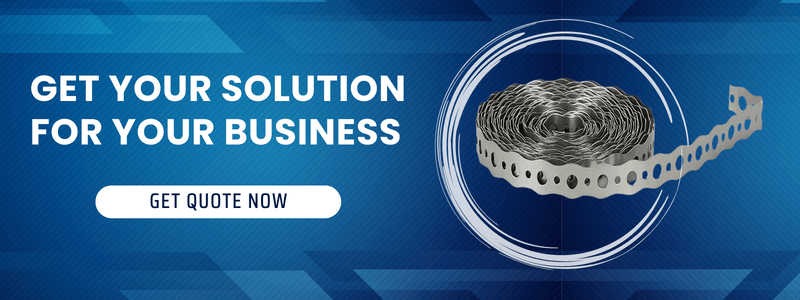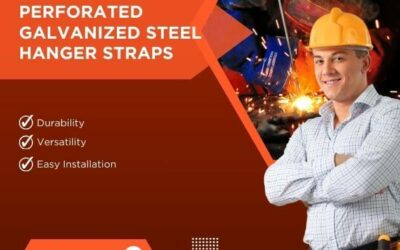Introduction
When it comes to securing and bundling materials, steel strapping is a popular choice due to its strength, durability, and versatility. However, not all steel strapping is created equal. Two of the most widely used options are galvanized steel strapping and stainless steel strapping. In this article, we’ll explore the key differences between these two materials, their respective strengths and weaknesses, and the factors that should be considered when choosing the right strapping solution for your application.
Corrosion Resistance: A Tale of Two Materials
Galvanized Steel and Its Sacrificial Protection
Galvanized steel strapping is created by coating regular carbon steel with a layer of zinc, which acts as a sacrificial anode. In environments where moisture and oxygen are present, the zinc coating corrodes instead of the underlying steel, providing a protective barrier against rust and corrosion. However, this protection is not foolproof – if the zinc layer is damaged or wears off, the steel can become vulnerable to corrosion.
Stainless Steel and Its Chromium-Powered Durability
On the other hand, stainless steel strapping owes its corrosion resistance to the presence of chromium, a key alloying element. When exposed to oxygen, chromium forms a passive layer of chromium oxide on the surface, which acts as a barrier against corrosion. This makes stainless steel strapping particularly well-suited for harsh environments, such as those with high salinity, acidic conditions, or exposure to chemicals.
Cost and Longevity: Weighing the Long-Term Investment
While galvanized steel strapping is often more affordable upfront, its protection against corrosion has a limited lifespan. As the zinc coating wears away, the underlying steel becomes vulnerable, potentially leading to premature failure and the need for replacement. Stainless steel strapping, on the other hand, tends to be more expensive initially but can offer a longer service life and reduced maintenance costs over time.
When considering the total cost of ownership, it’s essential to factor in not just the initial purchase price but also the potential costs associated with maintenance, replacement, and downtime due to strap failure. In some applications, the higher upfront cost of stainless steel strapping may be offset by its superior longevity and reduced need for replacement, making it a more cost-effective choice in the long run.
Environmental Impact: Sustainability in Focus
As businesses and consumers alike become increasingly conscious of their environmental footprint, the sustainability of materials has become a crucial consideration. In this regard, both galvanized steel and stainless steel strapping have their own unique advantages and challenges.
Galvanized Steel: The Zinc Factor
The production of galvanized steel involves the smelting of zinc, a process that can have significant environmental impacts if not properly managed. Zinc mining and smelting can lead to air and water pollution, as well as the generation of hazardous waste. Additionally, the disposal of galvanized steel products can pose challenges, as the zinc coating may require special handling to prevent environmental contamination.
Stainless Steel: Recyclability and Chromium Extraction
While stainless steel strapping is generally considered more environmentally friendly due to its durability and potential for recycling, the mining and processing of chromium, a key alloying element, can have negative impacts on the environment if not carried out responsibly. However, the recycling rate for stainless steel is significantly higher than that of galvanized steel, which can help offset some of these environmental concerns.
Industry Applications: Where Galvanized and Stainless Steel Shine
The choice between galvanized steel strapping and stainless steel strapping often comes down to the specific application and the environmental conditions it will be exposed to.
Galvanized Steel: A Versatile Choice for General Applications
Galvanized steel strapping is a popular choice for general applications where corrosion resistance is required but the environment is not excessively harsh. It’s commonly used in construction, packaging, and transportation industries, as well as in many outdoor applications where exposure to moisture and moderate levels of atmospheric pollutants is expected.
Stainless Steel: The Workhorse for Harsh Environments
When it comes to demanding environments, stainless steel strapping is often the preferred choice. Its superior corrosion resistance makes it well-suited for applications in the chemical, petrochemical, and food processing industries, where exposure to harsh chemicals, high temperatures, and aggressive cleaning agents is common. Stainless steel strapping is also a popular choice in marine environments, where the presence of salt water and high humidity can quickly degrade other materials.
Technological Innovations: Pushing the Boundaries
Both the galvanized steel and stainless steel industries are constantly innovating to improve the performance, durability, and cost-effectiveness of their products.
Advancements in Galvanized Steel Coatings
In the galvanized steel industry, researchers and manufacturers are exploring new coating techniques and alloy compositions to enhance the corrosion resistance and longevity of the zinc coating. For example, some manufacturers are experimenting with adding small amounts of aluminum or other elements to the zinc coating, which can improve its resistance to atmospheric corrosion and extend its service life.
Stainless Steel Alloy Developments
In the stainless steel realm, innovations are focused on developing new alloy compositions that offer improved corrosion resistance, strength, and formability while reducing production costs. For instance, the development of lean duplex stainless steels, which contain lower levels of expensive alloying elements like nickel, has made stainless steel more cost-effective for certain applications without compromising its performance.
Regulatory and Safety Considerations
In some industries, regulatory requirements and safety standards can play a significant role in determining the choice between galvanized steel strapping and stainless steel strapping.
Food and Beverage Industry Preferences
In the food and beverage industry, where product safety and hygiene are of paramount importance, stainless steel strapping is often the preferred choice. Its corrosion resistance and lack of potential zinc contamination make it a safer option for applications where the strapping may come into contact with food or beverages.
Aerospace and Automotive Regulations
Similarly, in the aerospace and automotive industries, where strict safety and performance standards are in place, stainless steel strapping may be required or preferred due to its superior strength, corrosion resistance, and consistent performance in demanding environments.
Conclusion
In the battle between galvanized steel strapping and stainless steel strapping, there is no one-size-fits-all solution. The choice ultimately depends on a variety of factors, including the application, environmental conditions, cost considerations, and regulatory requirements.
Galvanized steel strapping offers a cost-effective option for general applications where moderate corrosion resistance is required, while stainless steel strapping excels in harsh environments and applications where superior corrosion resistance, longevity, and product safety are paramount.
As technology continues to advance and sustainability becomes an increasingly important consideration, both industries are actively exploring new materials, coatings, and manufacturing processes to improve performance and reduce environmental impact.
Ultimately, understanding the strengths and limitations of each material, as well as the specific requirements of your application, is crucial in making an informed decision that balances cost, performance, and environmental considerations.
Secure Your Pipes with Galvanized Metal Straps: A Comprehensive Guide
Ensuring Pipe Stability and Longevity In the world of construction and plumbing, maintaining the structural integrity of piping systems is paramount. Galvanized metal pipe straps emerge as the unsung heroes, providing unwavering support and security to these vital...
Mastering 24 Gauge Galvanized Pipe Hanger Straps: A Useful Guide
In the realm of plumbing and construction, where every detail matters, securing pipes effectively is paramount. Enter the 24 gauge galvanized pipe hanger strap – a reliable and versatile solution trusted by both professionals and DIY enthusiasts alike. Understanding...
Perforated Metal Hanger Straps: Installation, Benefits, and Maintenance
Are you tired of dealing with sagging ductwork or unsupported pipes in your home or commercial building? Proper support is crucial for maintaining the integrity and efficiency of your HVAC and plumbing systems. That's where perforated metal hanger straps come into...

Justin Wong
Hi, I’m Justin, the technical engineer of Jiangmen Masters. We’ve been running a factory in China that makes metal hanger strap for 16 years now, and the purpose of this article is to share the knowledge related to metal hanger strap from a Chinese supplier’s perspective.




